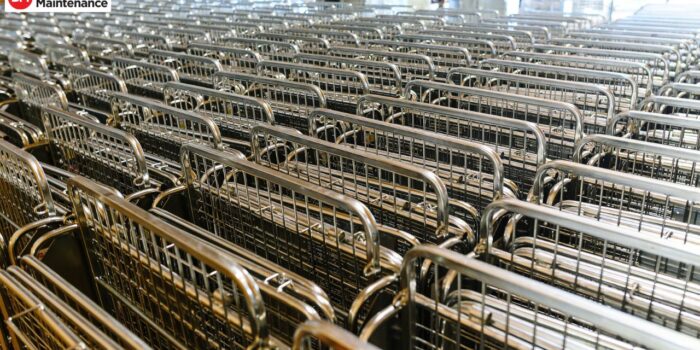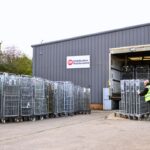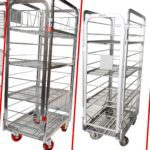Enhancing Distribution Efficiency with Heavy Duty Roll Cages
Distribution centres play an essential role in ensuring that goods reach consumers efficiently and on time. Among the tools that contribute significantly to this process are heavy duty roll cages. These robust and versatile devices have become indispensable for industries ranging from automotive to e-commerce, revolutionising the way goods are moved within distribution centres and enhancing overall efficiency.
Heavy duty roll cages are designed to withstand substantial loads and provide ease of movement. This article delves deeper into the design and applications of these roll cages, shedding light on their various features, benefits and real-world uses.
Key Design Features of Heavy Duty Roll Cages
The foundation of an effective roll cage lies in its design. Manufacturers employ a combination of structural components and durable materials to create roll cages capable of withstanding demanding loads. Robust metal frames, reinforced castor wheels, and ergonomic handles are just a few of the elements that contribute to the roll cage’s strength and durability.
Ergonomic design principles also play a pivotal role in ensuring that heavy duty roll cages are not only strong but also easy to use. Considerations like handle height, weight distribution, and manoeuvrability are taken into account to reduce strain on workers and enhance their overall experience.
Furthermore, innovative design elements are integrated to enhance safety and stability during distribution tasks. Features such as anti-tip mechanisms, secure locking systems, and shock-absorbing components minimise the risk of accidents, safeguarding both workers and products.
Customisation and Adaptability of Heavy Duty Roll Cages
One of the standout features of roll cages are their versatility and adaptability. Businesses can customise roll cage designs to suit their specific distribution needs, thereby maximising efficiency. Whether it’s configuring the cage to accommodate various types of goods, integrating specialised compartments, or incorporating technology such as barcode scanners and RFID systems, customisation enhances the roll cage functionality and its ability to seamlessly integrate with existing processes.
Real-world case studies illustrate the success of customisation efforts. For instance, in the automotive industry, roll cages have been tailored to fit specific parts and tools, resulting in streamlined assembly processes and improved order fulfilment. In the e-commerce sector, roll cage customisation has led to faster and more accurate order picking, reducing the time it takes to get products from the warehouse to the customer.
Optimising Distribution Processes with Roll Cages
Efficiency is the name of the game in distribution, and roll cages are key players in optimising various processes. Order picking and packing operations are streamlined as workers can easily transport multiple items at once, reducing the number of trips required. Additionally, roll cages facilitate efficient material movement within distribution centres, minimising congestion and improving overall flow.
By reducing turnaround times and optimising workflows, roll cages contribute to increased productivity and cost savings. Time once spent shuttling items back and forth is now allocated to more value-added tasks, resulting in improved customer satisfaction and reduced labour costs.
Enhancing Safety Measures with Heavy Duty Roll Cages
Safety is paramount in any distribution centre. The design of heavy duty roll cages prioritises worker well-being and accident prevention. Roll cages are equipped with features such as ergonomic handles to reduce strain, robust wheels for stability, and braking systems to prevent unintended movement. Anti-tip mechanisms and load-securing options further mitigate the risk of accidents, safeguarding workers and minimising product damage.
Comprehensive training and safety protocols complement the roll cage design, ensuring that workers are well-versed in proper handling techniques. Regular maintenance checks are conducted to identify and address any potential issues before they compromise safety or efficiency.
Sustainable Practices in Distribution Using Roll Cages
With sustainability being a growing concern, heavy duty roll cages are designed with eco-friendliness in mind. Durable construction materials extend the roll cage’s lifespan, reducing the need for frequent replacements. Reusable components and modular designs minimise waste, while efficient space utilisation optimises storage capacity, reducing the need for additional infrastructure.
Manufacturers are also exploring the use of eco-friendly materials and manufacturing processes to reduce the environmental footprint of heavy duty roll cages. By aligning with sustainability goals, businesses can contribute to a greener future while reaping the operational benefits of these roll cages.
Maintenance and Longevity of Roll Cages
Ensuring the longevity of roll cages requires a proactive maintenance approach. Regular inspections, lubrication of moving parts, and prompt replacement of worn components are essential to prevent breakdowns and extend the roll cage’s lifespan. Properly maintained roll cages not only operate more efficiently but also contribute to a safer work environment.
In cases where repairs are needed, manufacturers often provide replacement parts to keep downtime to a minimum. Training maintenance staff to identify and address common issues empowers businesses to maintain a reliable fleet of heavy duty roll cages.
Future Trends and Innovations in Roll Cages Design
The evolution of roll cages is far from over. The integration of automation and robotics promises to transform distribution centres by introducing autonomous roll cage movement. Smart roll cage technologies equipped with IoT sensors, data analytics, and real-time tracking are poised to revolutionise inventory management and enhance supply chain visibility.
Anticipated advancements in roll cage design include improved energy efficiency, enhanced connectivity, and advanced navigation capabilities. As technology continues to evolve, heavy duty roll cages are set to play an even more significant role in shaping the future of distribution.
In the realm of distribution, roll cages have emerged as indispensable tools for enhancing efficiency, optimising workflows, and ensuring worker safety. Their robust design, adaptability, and application-specific customisation make them valuable assets across various industries.
From automotive parts to e-commerce fulfilment and food distribution, heavy duty roll cages streamline operations, reduce labour-intensive tasks, and contribute to sustainable practices. As businesses continue to seek ways to improve distribution processes, heavy duty roll cages stand as a testament to the power of thoughtful design and innovation in driving success. As we look ahead to the future, the evolution of heavy duty roll cages is poised to further shape the distribution landscape, bringing about new levels of efficiency and productivity.









